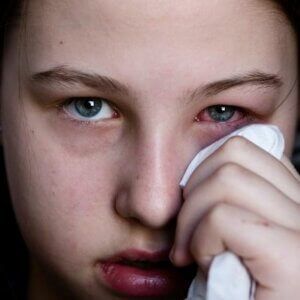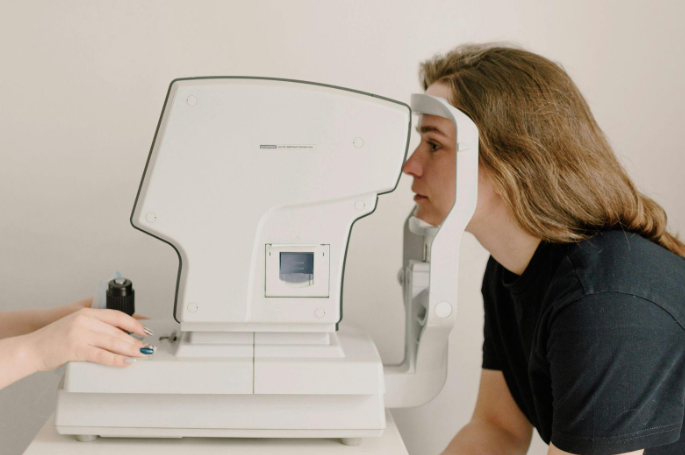What Causes Pink Eye (Conjunctivitis)?
Pink eye is a frustrating eye infection that can make your eyes feel uncomfortable and you feel embarrassed. It leaves you with eyes that are red as well as irritated, inflamed, and uncomfortable. But what causes pink eye and, more importantly, what can you do about it?
Pink eye can occur for a number of reasons, including viral infections, bacterial infections, allergies, and foreign bodies entering your eye. It’s more common in cold and flu season, making it extra important to wash your hands and sanitize surfaces. Symptoms can include redness in the eye, swollen eyelids, and watery discharge. Viral cases will heal on their own, but bacterial infections require medical treatment.
What causes pink eye?
Also known as conjunctivitis , pink eye is when the clear membrane that lines your eye and eyelid ( conjunctiva ) becomes infected or inflamed. This causes the blood vessels in the membrane to turn red or pink and become much more visible than usual, hence the nickname “pink eye.”
Pink eye can have multiple causes. In fact, it’s often a catch-all for whenever the eye becomes irritated and red. However, the medical term “conjunctivitis” actually refers to a:
- Viral infection
- Bacterial infection
- Allergic reaction
- Irritation
Pink eye is also common in infants due to tear ducts that haven’t opened completely. It can also be caused by foreign objects or chemicals that have found their way into your eye.
Viral Infections
Viral and bacterial infections are the most common causes of pink eye. Viral infections are usually due to the adenovirus , but they can also be caused by the herpes simplex virus , varicella-zoster virus , and the coronavirus that causes COVID-19.
Bacterial Infections
Bacterial infections can occur in a number of ways, including contact lenses and expired eye makeup . This is why it’s so important to clean your contacts regularly and never sleep in them. You should also replace makeup every 3 – 4 months, never share makeup, and keep your brushes and applicators clean.
Allergic Reactions
Allergic conjunctivitis occurs when you’ve been exposed to substances that you’re allergic to, such as pet dander or pollen. It affects both eyes and is your body’s way of fighting off perceived threats. In the fight to protect itself, your body releases histamines that cause other allergy symptoms such as sneezing and nasal discharge.
Irritation-Related Conjunctivitis
Sometimes you may get a foreign body such as sand or, worse yet, a chemical splashed in your eye. These can be minor irritants that pass with time or by properly flushing your eyes. On the other hand, they can also lead to long-term problems due to corneal abrasions or more caustic chemicals. Contact your eye doctor immediately if you experience these problems.
Click here to read our blog about corneal abrasions and how they can affect your vision.
Is pink eye more common in cold and flu season?

You can get pink eye any time of year, but you’re much more likely to get it during the winter. This is due to direct contact, which is the same reason the cold and flu are so common during this time. People spend more time inside this time of year, and hugging during the holidays also increases your risk. However, you’re more likely to pick it up from the surfaces of objects, so make sure to clean and sanitize after you have guests
You’re more likely to spread it to others if you have viral or bacterial pink eye during winter, so it’s important to take precautions. You can do this by:
- Washing your hands regularly
- Avoiding touching people who have it
- Avoiding or sanitizing surfaces that may be contaminated
You can also avoid conjunctivitis by getting some sun or talking to your doctor about taking a vitamin D supplement. The vitamin D we get from the sun’s rays is essential for a healthy immune system, but it’s harder to get when it’s cold and cloudy. You can protect yourself by making getting sunlight a priority this time of year, even if it’s just for a few minutes, and supplementing with a vitamin.
Click here to read our blog where we go deeper into the connection between conjunctivitis and winter.
Pink Eye Symptoms
Symptoms of pink eye are similar no matter what time of year you catch it. Common symptoms include:
- Redness of the eye
- Swollen eyelids
- Discharge from the eye
- An itchy, burning, or stinging sensation
No matter the cause or your symptoms, our team of ophthalmologists is here to help you. They can determine what type of pink eye you have in order to treat your condition.
Treating Pink Eye
Be sure to have your eye or eyes checked by your eye doctor if you have pink eye symptoms. You can’t know what type you have on your own, but they will. Viral cases go away on their own, but bacterial conjunctivitis will require medical treatment in order for it to get better. This may include using antihistamines and anti-inflammatories to get rid of the bacteria.
Your eye doctor will be able to recommend over-the-counter (OTC) eye drops or other medicines that can help. They can also give you advice on the best types of OTCs for your particular situation.
Are you concerned that you may have pink eye? Contact us today to schedule your appointment!
Viral infections, bacterial infections, allergies, and foreign substances can all cause pink eye. You’re actually at an increased risk for infection in colder months due to higher chances of direct contact with people or surfaces carrying viruses or bacteria. Common symptoms include eyes that are red, watery, and itchy. While viral cases will pass on their own, bacterial conjunctivitis will require medical treatment.
Baptist Eye Surgeons is an ophthalmological practice in Knoxville, TN, and Morristown, TN. Give us a call at 865-579-3920 for more information or to schedule an appointment .





